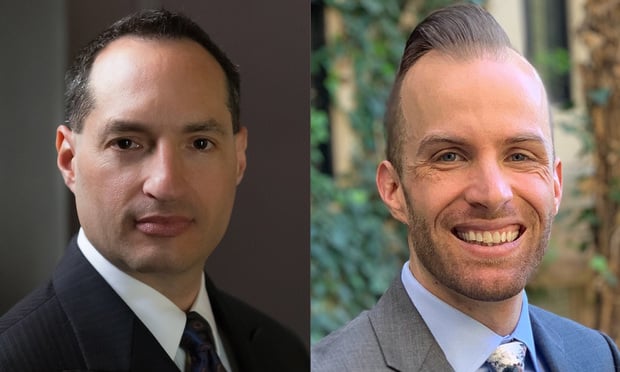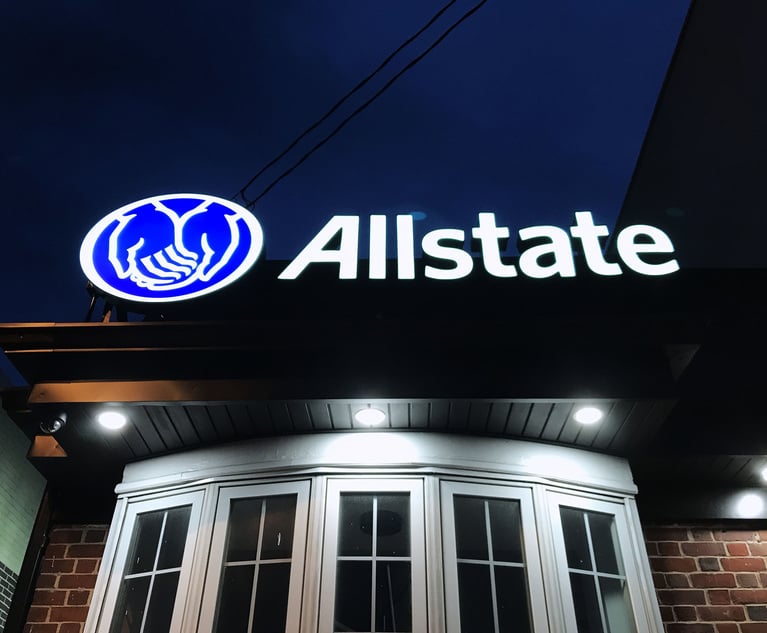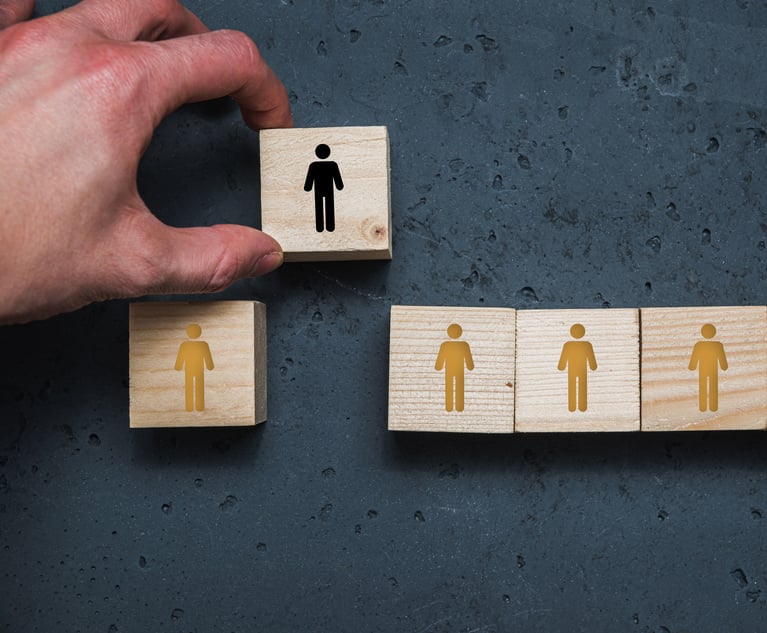Remote Jury Trials Are Possible, but Maybe Not the Best Idea
While remote jury trials are technically feasible and legally plausible, the twin risks of procedural injustice and rampant retrials reduce their appeal.
May 27, 2020 at 10:00 AM
7 minute read
 (L to R) David A. Carrillo, Lecturer in Residence and executive director, California Constitution Center at Berkeley Law and Matthew Stanford is an attorney and senior research fellow at the California Constitution Center (Photo: Courtesy Photo)
(L to R) David A. Carrillo, Lecturer in Residence and executive director, California Constitution Center at Berkeley Law and Matthew Stanford is an attorney and senior research fellow at the California Constitution Center (Photo: Courtesy Photo)
Trial courts in California and across the nation face a dilemma. Months have passed without jury trials. And as those cases originally set for trial during the outbreak await new trial dates, dockets continue to grow. Meanwhile, jury summonses will be even more unwelcome than usual. All this makes trial by remote jury alluring—especially for criminal cases, where speedy trial requirements demand swift solutions. While remote jury trials are technically feasible and legally plausible, the twin risks of procedural injustice and rampant retrials reduce their appeal.
Granted, most technical problems are solvable. Major security bugs that might have given courts pause at the outbreak's outset have largely been addressed. And videoconferencing has become at least a temporary fixture in U.S. professional and social life. Though far from a perfect substitute for in-person interaction, it has proven an effective stopgap measure as public health officials continue to encourage social distancing wherever possible. Like the virtual team meetings, happy hours and family visits everyone has tolerated for several months, remote jury service stands to offer the right blend of presence and distance to allow at least some trials to move forward without risking further infection. And for an in-custody criminal defendant unlikely to receive own recognizance release as the pandemic persists, proceeding to trial this way might well seem preferable to indefinite detention.
But the fact that no U.S. judiciary has ever tried mass-scale remote jury trials means that there's little law to guide courts if they attempt this procedure. As far as we can tell, nothing clearly prohibits a trial judge from empaneling a remote jury. While the U.S. Supreme Court has addressed the constitutionality of substituting in-person testimony with closed-circuit video or videotaped examinations, it has never considered the need for jurors to be physically present. Indeed, the Court's test for such accommodations, first announced in Maryland v. Craig (1990) 497 U.S. 836, suggests that a confrontation clause challenge to remote juries would fail. Unlike out-of-court witnesses, remote juries do not obviously undermine the "elements of effective confrontation—oath, cross-examination and observation of the witness'[s] demeanor" that the Sixth Amendment requires. While remote witness examinations obviously pose a closer question, including jurors among a defendant's "accusers" seems a stretch.
Due process concerns pose the biggest problem. While jurors' short attention spans and limited ability to evaluate witness credibility do not bar the use of closed circuit video or recorded testimony for uniquely vulnerable witnesses (children, informants, etc.), what minimum process defendants are constitutionally due when it comes to ensuring juror engagement remains unknown. A Texas judge recently permitted an advisory civil jury to attend by videoconference—and one juror walked off to take a phone call during a break in the proceedings. No one can predict the consequences on appeal if that happens in a criminal case.
A presiding judge would at least have authority for an experiment with this procedure. Trial courts have inherent powers to organize their dockets. And in California, a county's presiding judge can also rely on several statutory procedures for rearranging cases during an emergency, and on the governor's delegation of broad discretionary powers to the state's chief justice in the current pandemic to take all necessary actions. Trial judges have broad discretion over how a jury is situated—and cases supporting the proposition that the trial judge has similarly great discretion in managing a trial are legion. That discretion permits ordering jury sequestration and separation, taking juries on field trips for scene views, and permits remote testimony by live or recorded video evidence. If a jury can sit in a courtroom and view live testimony on a screen from a remote witness, why can't the seating positions be reversed?
The answer is "no one knows"—and that uncertainty is the problem. The first batch of convictions via remote jury will face a phalanx of constitutional challenges on appeal. Though far from a scientific poll, most of our criminal justice colleagues were skeptical that convictions by remote juries would survive due process challenges on appeal. And they questioned a trial judge's ability to control juror activity if they're not in the same room. There's also a greater risk of juror tainting if the videoconference gets interrupted (however briefly) by the technical errors that bedevil every remote video system.
These concerns make this more of a "should we" than a "can we" question. Choosing a few test cases initially seems like a good option. Doing so would give intermediate appellate and high courts an opportunity to examine the practice without forcing trial courts to retry countless cases should it prove unconstitutional. Trial courts could at least benefit from some guidance about which factors to consider regarding whether to proceed remotely. Not all courts enjoy the same levels of technological capacity, available space to keep jurors socially distanced, or administrative support for such an undertaking. Even if a bright-line rule never comes, a few test cases on appeal could give trial courts a better sense of how best to implement the practice. Of course, that all takes time—and the whole point of doing remote juries is to restart trials expeditiously. And, like Article III courts, the California Supreme Court does not issue advisory opinions.
Trial courts might also consider a hybrid approach: virtual jury selection, with the trial itself conducted in person. Even if due process requires that the empaneled jury must be physically present, the initial screening process could be done remotely. Hardship requests, juror questionnaires, and even some juror strikes could be done without corralling dozens or even hundreds of potential jurors into an assembly room. Attorneys could question potential jurors by phone or video chat. Alternatively, judges could administer voir dire in smaller groups, or spread potential jurors across multiple courtrooms connected via video. Once the jury is selected, judges could spread masked-and-gloved jurors across the courtroom gallery, or place jurors in separate offices with government-issued computers connected to the courtroom via webcam. This middle ground addresses concerns about internet access, network security, technical failures, and juror engagement by limiting the technological environment and placing jurors under more direct judicial supervision. Another hybrid option is to limit remote juries to civil trials where both parties stipulate to the procedure.
There are no good solutions here, and trial courts must balance these concerns based on local conditions. Doing nothing means criminal defendants languish in custody indefinitely. Test cases require parties to endure the status quo while verdicts are appealed. And adopting remote juries wholesale risks mass retrials. But all this uncertainty also means some parties will reach settlements and plea deals, or possibly opt for bench trials. Whatever procedure trial courts adopt should be the one that best spares parties, courts and jurors the potentially calamitous costs of gambling on a practice whose constitutional footing, while promising, remains uncertain.
David A. Carrillo is the executive director of the California Constitution Center at Berkeley Law. He teaches courses on the California constitution and the California Supreme Court, publishes articles on those subjects, and edits SCOCAblog.com, a blog about the state high court. Matthew Stanford is an attorney and senior research fellow at the California Constitution Center.
This content has been archived. It is available through our partners, LexisNexis® and Bloomberg Law.
To view this content, please continue to their sites.
Not a Lexis Subscriber?
Subscribe Now
Not a Bloomberg Law Subscriber?
Subscribe Now
NOT FOR REPRINT
© 2025 ALM Global, LLC, All Rights Reserved. Request academic re-use from www.copyright.com. All other uses, submit a request to [email protected]. For more information visit Asset & Logo Licensing.
You Might Like
View All
State Appeals Court Revives BraunHagey Lawsuit Alleging $4.2M Unlawful Wire to China
3 minute read

Apple Disputes 'Efforts to Manufacture' Imaging Sensor Claims Against iPhone 15 Technology

Lawsuit alleges racial and gender discrimination led to an Air Force contractor's death at California airfield
7 minute readTrending Stories
- 1New York-Based Skadden Team Joins White & Case Group in Mexico City for Citigroup Demerger
- 2No Two Wildfires Alike: Lawyers Take Different Legal Strategies in California
- 3Poop-Themed Dog Toy OK as Parody, but Still Tarnished Jack Daniel’s Brand, Court Says
- 4Meet the New President of NY's Association of Trial Court Jurists
- 5Lawyers' Phones Are Ringing: What Should Employers Do If ICE Raids Their Business?
Who Got The Work
J. Brugh Lower of Gibbons has entered an appearance for industrial equipment supplier Devco Corporation in a pending trademark infringement lawsuit. The suit, accusing the defendant of selling knock-off Graco products, was filed Dec. 18 in New Jersey District Court by Rivkin Radler on behalf of Graco Inc. and Graco Minnesota. The case, assigned to U.S. District Judge Zahid N. Quraishi, is 3:24-cv-11294, Graco Inc. et al v. Devco Corporation.
Who Got The Work
Rebecca Maller-Stein and Kent A. Yalowitz of Arnold & Porter Kaye Scholer have entered their appearances for Hanaco Venture Capital and its executives, Lior Prosor and David Frankel, in a pending securities lawsuit. The action, filed on Dec. 24 in New York Southern District Court by Zell, Aron & Co. on behalf of Goldeneye Advisors, accuses the defendants of negligently and fraudulently managing the plaintiff's $1 million investment. The case, assigned to U.S. District Judge Vernon S. Broderick, is 1:24-cv-09918, Goldeneye Advisors, LLC v. Hanaco Venture Capital, Ltd. et al.
Who Got The Work
Attorneys from A&O Shearman has stepped in as defense counsel for Toronto-Dominion Bank and other defendants in a pending securities class action. The suit, filed Dec. 11 in New York Southern District Court by Bleichmar Fonti & Auld, accuses the defendants of concealing the bank's 'pervasive' deficiencies in regards to its compliance with the Bank Secrecy Act and the quality of its anti-money laundering controls. The case, assigned to U.S. District Judge Arun Subramanian, is 1:24-cv-09445, Gonzalez v. The Toronto-Dominion Bank et al.
Who Got The Work
Crown Castle International, a Pennsylvania company providing shared communications infrastructure, has turned to Luke D. Wolf of Gordon Rees Scully Mansukhani to fend off a pending breach-of-contract lawsuit. The court action, filed Nov. 25 in Michigan Eastern District Court by Hooper Hathaway PC on behalf of The Town Residences LLC, accuses Crown Castle of failing to transfer approximately $30,000 in utility payments from T-Mobile in breach of a roof-top lease and assignment agreement. The case, assigned to U.S. District Judge Susan K. Declercq, is 2:24-cv-13131, The Town Residences LLC v. T-Mobile US, Inc. et al.
Who Got The Work
Wilfred P. Coronato and Daniel M. Schwartz of McCarter & English have stepped in as defense counsel to Electrolux Home Products Inc. in a pending product liability lawsuit. The court action, filed Nov. 26 in New York Eastern District Court by Poulos Lopiccolo PC and Nagel Rice LLP on behalf of David Stern, alleges that the defendant's refrigerators’ drawers and shelving repeatedly break and fall apart within months after purchase. The case, assigned to U.S. District Judge Joan M. Azrack, is 2:24-cv-08204, Stern v. Electrolux Home Products, Inc.
Featured Firms
Law Offices of Gary Martin Hays & Associates, P.C.
(470) 294-1674
Law Offices of Mark E. Salomone
(857) 444-6468
Smith & Hassler
(713) 739-1250






